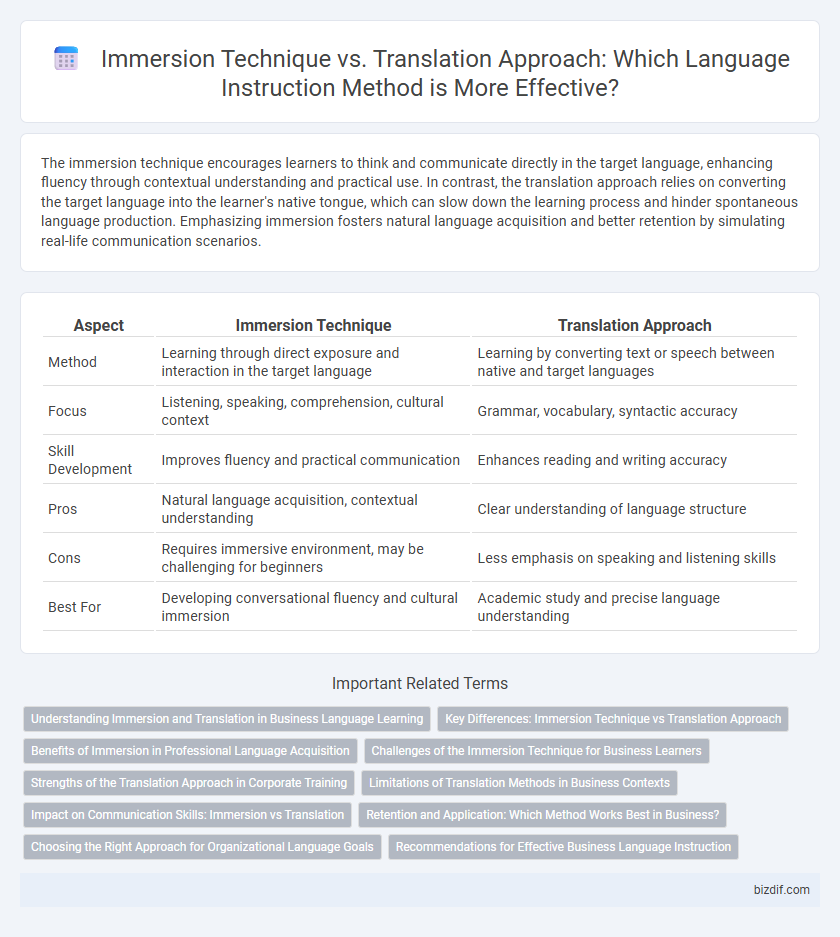The immersion technique encourages learners to think and communicate directly in the target language, enhancing fluency through contextual understanding and practical use. In contrast, the translation approach relies on converting the target language into the learner's native tongue, which can slow down the learning process and hinder spontaneous language production. Emphasizing immersion fosters natural language acquisition and better retention by simulating real-life communication scenarios.
Table of Comparison
| Aspect | Immersion Technique | Translation Approach |
|---|---|---|
| Method | Learning through direct exposure and interaction in the target language | Learning by converting text or speech between native and target languages |
| Focus | Listening, speaking, comprehension, cultural context | Grammar, vocabulary, syntactic accuracy |
| Skill Development | Improves fluency and practical communication | Enhances reading and writing accuracy |
| Pros | Natural language acquisition, contextual understanding | Clear understanding of language structure |
| Cons | Requires immersive environment, may be challenging for beginners | Less emphasis on speaking and listening skills |
| Best For | Developing conversational fluency and cultural immersion | Academic study and precise language understanding |
Understanding Immersion and Translation in Business Language Learning
Immersion technique in business language learning accelerates fluency by surrounding learners with authentic language use in real-world contexts, fostering intuitive comprehension and practical communication skills. Translation approach emphasizes precise equivalence between the native and target languages, enhancing vocabulary acquisition and grammatical accuracy but may slow conversational flow. Effective corporate language programs integrate immersion to build spontaneous interaction abilities while using translation to solidify foundational language structures and industry-specific terminology.
Key Differences: Immersion Technique vs Translation Approach
The Immersion Technique emphasizes learning a language through continuous exposure and natural communication without relying on the learner's native language, fostering intuitive comprehension and fluency. In contrast, the Translation Approach focuses on direct conversion between the target and native languages, highlighting grammatical rules and vocabulary memorization. While immersion enhances contextual understanding and speaking skills, the translation method prioritizes accuracy in reading and writing through explicit instruction.
Benefits of Immersion in Professional Language Acquisition
Immersion technique in professional language acquisition accelerates fluency by surrounding learners with real-life communication scenarios, enhancing practical speaking and listening skills. This method fosters cultural understanding and contextual usage, leading to better retention and more natural language application. Immersion also increases cognitive engagement, promoting quicker adaptation to professional jargon and nuanced expressions essential for workplace interactions.
Challenges of the Immersion Technique for Business Learners
Business learners face significant challenges with the immersion technique, including limited vocabulary relevant to corporate jargon and industry-specific terms. The rapid pace of immersive environments can overwhelm learners, hindering comprehension and retention of complex business concepts. Furthermore, the lack of explicit translation support may delay understanding critical business communications and negotiations.
Strengths of the Translation Approach in Corporate Training
The Translation Approach in corporate language training offers precise comprehension by directly linking new vocabulary and concepts to native language equivalents, facilitating clear understanding of complex business communication. It enables employees to quickly grasp industry-specific terminology and legal jargon, enhancing accuracy in contracts and reports. This method supports measurable progress through standardized assessments, ensuring effective skill acquisition aligned with organizational goals.
Limitations of Translation Methods in Business Contexts
The translation approach in business language instruction often limits effective communication by fostering reliance on native language structures, which can impede fluency and real-time decision-making. This method may fail to capture the nuanced terminology and cultural context essential for accurate business interactions and negotiations. Consequently, it reduces learners' ability to engage dynamically in complex business environments, hindering the development of practical language skills critical for global commerce.
Impact on Communication Skills: Immersion vs Translation
Immersion technique enhances communication skills by encouraging direct use of the target language in real-life contexts, fostering fluency, pronunciation accuracy, and cultural understanding. In contrast, the translation approach relies heavily on converting between native and target languages, which may slow spontaneous speaking and limit real-time conversational abilities. Research shows learners using immersion improve speaking and listening skills more rapidly, leading to greater confidence in communication.
Retention and Application: Which Method Works Best in Business?
Immersion technique enhances retention and application in business language learning by creating real-life contexts that reinforce practical communication skills. Translation approach may improve understanding of grammar and vocabulary but often limits spontaneous language use, reducing long-term retention. Studies show immersion fosters quicker fluency and better adaptability in professional environments, making it more effective for business communication mastery.
Choosing the Right Approach for Organizational Language Goals
Selecting the ideal language instruction method depends on an organization's specific goals and workforce needs. The Immersion Technique accelerates fluency by surrounding learners with the target language in context-rich environments, ideal for roles requiring quick conversational ability. The Translation Approach suits organizations emphasizing accuracy and comprehension of technical or written materials, promoting deeper understanding through direct language comparisons.
Recommendations for Effective Business Language Instruction
For effective business language instruction, prioritize immersion techniques that simulate real-world corporate environments to enhance practical communication skills and cultural fluency. Incorporate industry-specific vocabulary and role-playing scenarios reflecting actual business interactions to boost retention and confidence. Supplement immersion with targeted translation exercises to clarify complex terminology and ensure precise understanding of critical business concepts.
Immersion Technique vs Translation Approach Infographic

 bizdif.com
bizdif.com